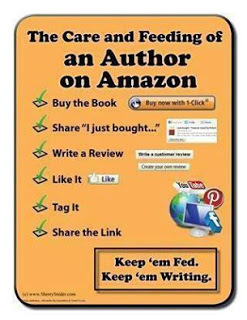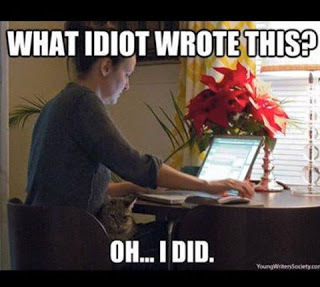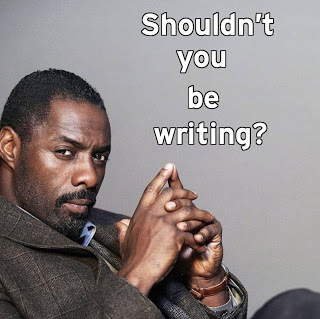Austin S. Camacho's Blog, page 10
May 1, 2016
Low Budget Marketing – 2
 Last week I started my list of ways to market your book on a tight budget. I mentioned putting a letter to fans at the back of your book and getting web site for your book. Next: let’s talk Facebook.
Last week I started my list of ways to market your book on a tight budget. I mentioned putting a letter to fans at the back of your book and getting web site for your book. Next: let’s talk Facebook.You probably already have a Facebook page. That’s good, but a Facebook Fan page is better. This is the place you can share all your writing news, and prompt discussions about your books, without wandering thru the more personal posts your friends and family add to your personal page.
To nurture those super fans I mentioned last week, I recommend you set up a Facebook group. This can become like the VIP lounge for your best supporters and fans. This is where you’ll put the special contests, advance views of your covers and sample chapters, and whatever other bonus content you can think up. What’s cool about groups is that you can restrict them to only the people you invite in so it’s exclusive for those special people.
Facebook isn’t the only free platform that pays off. It’s to your advantage to build a profile on Goodreads too. It’s a good place to gather another group of friends.
Once you’ve established yourself on Goodreads, you can plan a giveaway. In general, contests are a great way to promote your books, and you can get a lot of promotion out of giving away just one or two books. This is something you should share with all your followers, on ALL the social media platforms you use. Honestly, it’s hard to mess up, but there are some ideas that can make it better in this video: https://www.youtube.com/watch?v=QS198mSe58s
Where else can you get people’s attention for free? Take a look at Wattpad. It’s not as well known as Facebook or Goodreads but it is growing. It’s a place you can get eyes on your work by sharing sample chapters, short stories and other cool content. Wattpad offers a good chance to get both good feedback and a few more fans.
While I think it’s hard to overstate the value of social media it should not absorb too much of your time. To help with that I think it will aid your marketing efforts if you use one of the social media management tools. I use Hootsuite for my posting. It makes it easy to schedule posts for future times and even tells me the most effective times to post. I’ve heard that SocialOomph and Tweepi are also very useful. There are lots of other options out there. You should test out a few on this list - https://www.searchenginejournal.com/top-10-tools-managing-social-media-accounts/87843/- and make use of whichever is most comfortable for you.
I’ll toss out another handful of marketing tips next week – I hope one or two is useful to you.
Published on May 01, 2016 17:55
April 26, 2016
Low Budget Book Marketing
 Recently a fellow author commented to me that he thought his book would catch fire if he had the money to market it properly. So, short on cash, he was doing almost nothing to get his book sold.
Recently a fellow author commented to me that he thought his book would catch fire if he had the money to market it properly. So, short on cash, he was doing almost nothing to get his book sold.“Are you kidding?” I asked. “I can probably name a hundred ways to market your book that cost nothing, or very little.”
“Oh yeah?” he said. “Like what?”
Well, rather than bore one friend, I decided to try a blog series
So, here we go!
One of the most effective marketing strategies is to nurture your super fans. These are those fans who not only love your work but who love to share it with friends more than the average fan. The super fan is working to sell your books, sometimes as hard as you are. The challenge is finding them and engaging them. Here’s one way to do both: add a letter to fans to the back of your next book. The letter should invite them to do just two or three simple things: post a review, friend you on Facebook or Twitter, perhaps send you an email so you can add them to your mailing list. When someone does these things they have identified themselves as at least a potential super fan. When you reply to the email thanking them for the review, friend or follow them back, you have engaged them.
Next, get a web site for your book. As soon as you are certain of the title of our book, buy that domain name. Right now you can get a domain name for less than $15. It should be the most obvious thing a person would think of when they go online to look for you, with a couple exceptions. Avoid hyphens or underscores, because people looking for your book will most often forget to put them in. And stick with .com, because that’s everyone’s first guess. True, .net or something else may sound classy, but many people will give up after their first guess and never get to see your web site. And you do need a web site. Resist the recent urge to use your or Facebook page as your website.
I’ll chat about a couple more free or very inexpensive marketing ideas next week. I might not make it to 100, but it will be interesting to see how far I get. And if you would like more detail about one of them, let me know. That can be its own blog someday.
Published on April 26, 2016 09:11
April 16, 2016
How to Make an Author Smile
 Recently I’ve been surprised by a couple of avid readers asking me a question whose answer seemed too obvious to need explanation. They wanted to know what they could do to help their favorite authors succeed. They were clearly sincere, so I think maybe it’s not a bad thing to state some things a writer might be reluctant to tell you himself. Here are a few ways you can help your favorite author.
Recently I’ve been surprised by a couple of avid readers asking me a question whose answer seemed too obvious to need explanation. They wanted to know what they could do to help their favorite authors succeed. They were clearly sincere, so I think maybe it’s not a bad thing to state some things a writer might be reluctant to tell you himself. Here are a few ways you can help your favorite author.Buy the books: If they’re a favorite you probably already own their books, and I’m not prompting you to waste money. But every year you scratch your head over what to buy any number of friends and family members for birthdays, Christmas, anniversaries, house warming and other gifts. If they are YOUR friends or relatives they probably read. Why not give them a book by an author you love. And if you can get it autographed, that makes it a really personal gift.
Review the books: Recent research indicates that many people choose books based on the reviews they get – not just the ratings, but the number and the reasons reviewers say they liked them. So take a few minutes and reward that author for giving you a good time by posting a review on Amazon or Goodreads, or Barnes and Noble. It doesn’t have to be work and it needn’t be a literary masterpiece. Just say, “I really enjoyed this book because… “
Recommend the books: List them on your Goodreads page as recommended reading. Talk about them in any club or group you belong to. And of course if you’re a member of a book club suggest that your favorite author’s works be a selection for an upcoming meeting. Remember, most authors would love to visit your book club, or speak at a meeting of whatever club or group you belong to including civic groups like the Rotary. And if your friends or coworkers read, recommend the books to them too.
Engage on social media: If your favorite author has a Facebook page, be a friend. If they have a separate author page, like it. Follow him or her on Twitter. If they have blog, follow that too. And don’t forget to share the author’s posts, tweets and blog posts. Sharing this way is much like a personal recommendation. It’s also great to comment on their posts so get engaged. Writers love that. Know what else they love? Seeing a picture of you, the fan, on Facebook holding their book!
Finally, ask the author: A simple question like “What can I do to help you?” might let your favorite writer know it’s okay to ask for help. Maybe you can ask the local library to get his or her book. Maybe you can ask a local bookstore to carry it (or host an author event.) Maybe you can share some bookmarks or post cards with people you know. Or your author might have something in mind that I haven’t thought of.
Just know that no author can really succeed without support from readers, and that all that help is very much appreciated by every one of us!
Published on April 16, 2016 11:34
April 9, 2016
Rewriting - The Final Steps
 We’ve been working on rewriting our draft manuscript and there’s more to do. For instance, while you’re looking at your dialog, check to make sure your characters aren’t telling each other things they already know. In your first draft it might feel like the easy way to fill in backstory, but it’s poor storytelling technique. You DON’T want your story to feel like an episode of CSI.
We’ve been working on rewriting our draft manuscript and there’s more to do. For instance, while you’re looking at your dialog, check to make sure your characters aren’t telling each other things they already know. In your first draft it might feel like the easy way to fill in backstory, but it’s poor storytelling technique. You DON’T want your story to feel like an episode of CSI.Now for closer sentence editing, which can begin with a search for weak verbs. The most commonly used verb in the English language is the verb to be. It is, it was, it always will be. It’s so easy to use, we are often tempted to lean on it like a crutch. But nothing just IS. So go back through your work and see what else that person or thing is doing besides BEING. Sure, IT WAS HOT that day. But that sentence is passive AND weak, and a cliché besides. How about “The weather was hot?” Well, not passive anymore. But if you said, “The sun baked our skins” or “The heat made the air too think to breathe,” or even, “the temperature soared that morning.” Well now you’ve got some stronger, action verbs in the mix. It’s worth it to take the time to make even the weather an active event.
Now check point of view. Stories are always told from someone’s point of view, even if written in the third person. One thing my editor always hits me for is switching points of view. If you have a paragraph that is about Jane’s feelings, don’t tell us in the middle of that paragraph how Bob feels. Jane can only guess at how Bob feels. You can always show us what Bob is doing that let’s Jane know how he feels. But even one sentence from the other person’s perspective will kill your story’s flow.
If you go through all the steps we’ve discussed in the past three weeks your manuscript is probably as good as it can get…EXCEPT… with small word switches and sentence changes new errors sneak in. So the last step in rewriting is a final spell check and grammar review. Now your manuscript is polished like a fine jewel, ready for others to read.
Published on April 09, 2016 09:29
April 3, 2016
Say what they say, only better
 We've been talking about rewriting a first draft. When doing so, it makes sense to pay particular attention to your dialog.
We've been talking about rewriting a first draft. When doing so, it makes sense to pay particular attention to your dialog.Sometimes we can have our characters say all the right things but might still want to rewrite some of our dialog. Here’s an example of trying too hard to make dialog more colorful:
“I won’t put up with it,” Eve shrieked. “I’ll leave you if it happens again.”“You can’t do that,” Adam moaned. “You’re a part of me.”“Not anymore,” Eve snapped. “But I love you,” Adam whined weakly.“Then your time in paradise is over,” she chortled.
She chortled? In an effort to make this dialog more interesting, I have made it laughable. The point is there’s nothing wrong with the simple word “said” in dialog. Is that boring? Only to you, the writer. Actually, the word “said” is neutral, almost invisible. And because it does not draw attention to itself, it keeps the reader’s focus on your characters’ words.
To vary dialog it’s much better to change the format and add some action or description. Here’s one way to rewrite the passage above.
Eve’s words exploded at him. “I won’t put up with it! I’ll leave you if it happens again.”“You can’t do that,” Adam said. Pain showed on his face. “You’re a part of me.”“Not anymore.” “But I love you,” Adam said in a low, childlike voice.“Then your time in paradise is over.”
There’s the same conversation with only one “said” and no substitute verbs. The “said” substitutes are the lazy way out so it’s not weird that they would show up in a first draft. But disposing of them should be part of your rewrite strategy. Letting us see what’s happening between characters involves the reader in the conversation so much better than clues like “Adam whined.” So in your rewrite use the old reliable word, “said” along with other, equally neutral substitutes like “replied” or “asked” and find better ways of letting us know that your character smiled, hissed or sputtered.
In my first draft haste I also often overuse adverbs. Is that bad? Well it is if your work comes out looking like this:
Tommy was startled when he opened the door and Mike walked in.“What are you doing here?” Tommy asked nervously.“I’m looking for you,” Mike said angrily. “Where have you been all day?”“I had to leave,” Tommy said softly. “The thing in the closet sent me away.”“Thing in the closet?” Mike said fiercely. “I’ve had enough of this nonsense. I’m going in there and toss everything out.”“No, no,” Tommy said, frantically. “If you go in there it will kill you.”
Adverbs are the easy way (that is, the lazy way) to try to make your writing more expressive. However, they are almost always unnecessary, and they tempt us to avoid the “show don’t tell” rule. So rather than telling the reader that Mike is angry or that Tommy is frantic, in the rewrite I’d try to show what they are doing or how they are acting that makes it clear. For example, when Mike burst in, the next line could be,
“What are you doing here?” Tommy asked, stuttering a little, his eyes jumping left and right.
With that little description we know he answered nervously.
There’s more to a good line-by-line rewrite. I’ll share some more thoughts on this next week.
Published on April 03, 2016 17:44
March 27, 2016
The Bottom Line...By Line
Last week we talked about structural rewriting for your new manuscript. This week we’ll begin rewriting on the sentence level, sometimes called line editing when you get someone else to do it. This means it’s time to set theory aside and focus on the mechanics.
Hopefully you’ve had others read your draft. They can spot on thing you are not likely to: words and phrases you overuse. Over time you’ll develop a list of such words. My list includes suddenly, good, very, just and not quite. When you know what yours are you can search for them and replace them with greater variety.
Now read through your work and look for clichés. Sometimes it will seem that something did happen in the nick of time, or that “diamond in the rough” is the best way to describe a character. But in truth, a phrase everyone has heard before is never the best choice. Either cut such phrases or change them. Sometimes replacing one word in a cliché will make your sentence seem very fresh. Describing a woman as a rare opal in the rough might make a reader consider what that might really mean.
You’ll want to examine every sentence for unnecessary words. If a word (or a phrase, or a sentence) can be deleted without affecting the story flow, get rid of it.
My next step is to seek out passive writing. I’m looking for examples like this:“It was reported today that policy was not followed during the recent election. Mistakes were made. Excuses will be given. And we have been assured that appropriate punishment will be meted out.”
You may have seen something of the sort in your local newspaper. You may even be wondering what’s wrong with it. This kind of bureaucratic, stilted language is common in government circles. It’s called passive language, which just means that instead of leading the sentence with the subject you begin with the object. Most of your sentences should be in active construction – John hit the ball – as opposed to passive - the ball was hit by John. The problem with passive writing is it’s easy to lose the subject entirely. In the sentence “Mistakes were made” the mistakes are the OBJECT. But who made them? Maybe this is why politicians and government workers often write this way. But I want my fiction to be clearer than that.
There’s more to be done during the write, but that’s a start.
Hopefully you’ve had others read your draft. They can spot on thing you are not likely to: words and phrases you overuse. Over time you’ll develop a list of such words. My list includes suddenly, good, very, just and not quite. When you know what yours are you can search for them and replace them with greater variety.
Now read through your work and look for clichés. Sometimes it will seem that something did happen in the nick of time, or that “diamond in the rough” is the best way to describe a character. But in truth, a phrase everyone has heard before is never the best choice. Either cut such phrases or change them. Sometimes replacing one word in a cliché will make your sentence seem very fresh. Describing a woman as a rare opal in the rough might make a reader consider what that might really mean.
You’ll want to examine every sentence for unnecessary words. If a word (or a phrase, or a sentence) can be deleted without affecting the story flow, get rid of it.
My next step is to seek out passive writing. I’m looking for examples like this:“It was reported today that policy was not followed during the recent election. Mistakes were made. Excuses will be given. And we have been assured that appropriate punishment will be meted out.”
You may have seen something of the sort in your local newspaper. You may even be wondering what’s wrong with it. This kind of bureaucratic, stilted language is common in government circles. It’s called passive language, which just means that instead of leading the sentence with the subject you begin with the object. Most of your sentences should be in active construction – John hit the ball – as opposed to passive - the ball was hit by John. The problem with passive writing is it’s easy to lose the subject entirely. In the sentence “Mistakes were made” the mistakes are the OBJECT. But who made them? Maybe this is why politicians and government workers often write this way. But I want my fiction to be clearer than that.
There’s more to be done during the write, but that’s a start.
Published on March 27, 2016 07:11
March 19, 2016
Let's Do It Again
 If your good idea became a strong plot, if you wrote a good outline and overcame all the blocks that arise, you may now have what you’d call a manuscript. Unless you’re a seasoned writer, in which case, you’d call it a first draft.
If your good idea became a strong plot, if you wrote a good outline and overcame all the blocks that arise, you may now have what you’d call a manuscript. Unless you’re a seasoned writer, in which case, you’d call it a first draft.Writing is rewriting. We hear it all the time but new writers may not know exactly what it means. When you move back to the start of your first draft it’s easy to get caught up in the line edit process – working at the sentence level, changing or deleting words to strengthen the prose. However I would suggest that rewriting begins with a more structural approach.
So step one: toss that draft in a drawer, or put that fine where you won’t see it, for a couple of weeks. You’re going to need to look at your story with fresh eyes.
Now, read your book like it’s someone else’s. Look at it as big-picture as possible. Is this the right genre? (I thought I was writing a mystery but the romance could take over.) Do events happen in the best order? (Maybe the elves should attack before the dragon appears.) You might want to reconsider the setting, relationships between characters, even the point of view. Rethink every structural underpinning of your story and be willing to make real changes.
Also try to feel the level of narrative tension throughout the book. Does the threat or danger increase too quickly or too predictably? Is your protagonist too confident, or too tough? Fix it in the rewrite.
BTW, the most common positive structural change is to cut the opening and start the story later. Many great writers still tend to start the story too early and go into too much detail. Be certain that your novel starts at the best point.
And what about the ending? Did you tie up all the loose ends or did you leave unanswered questions that will keep the reader from being satisfied?
This structural process may involve a lot more thinking and re-reading than actual writing. And when it’s finished your manuscript may be quite the tumbled mess. But that’s okay. Because now it’s time to start the sentence level rewriting. We’ll talk about that next week
Published on March 19, 2016 17:46
March 13, 2016
Writing Through It
 We started the year getting you started on your novel, and have spent recent weeks trying to keep you going despite the many inner demons that try to stop you.
We started the year getting you started on your novel, and have spent recent weeks trying to keep you going despite the many inner demons that try to stop you.Sometimes you hit a wall and suspect that the reason is a bad choice you made several chapters back. You can even see where the story would be if you hadn’t added that one plot element. This is devastating to the confidence. But, in my opinion, when you find yourself in a hole the first thing to do is stop digging. If you know what your story ought to be at this point, go on from there as if it has gone the right way all along. Yes, that leaves you with a big hole you will have to fill in later, but you’re no longer stuck. At the end you’ll look back and realize you have two different timelines in your story. Go back and make everything fit the new timeline and let the original one die.
I’ve gotten stuck on occasion because I get bored with my characters. They’re not doing anything interesting and I start to tell myself it’s their fault. Actually, if they’re boring it’s probably because I haven’t figured out what they really want. I’ve got to find the conflict that will push them into real action. And if I wrote pages and pages of doing boring things at least I learned more about them. Once I know what these people are really about, I’ll find their real central conflict. Then I need the courage to cut all those boring pages and get right to the stuff that matters.
Lack of confidence can cause writer’s block all by itself. You start imagining all the reasons some critic will say your story is bad, and that keeps you from making any decision. But trust me, the ideas you come up with are never as bad as your fear makes you believe. So drive on thru your first draft, knowing you can fix whatever’s flawed in the rewrite.
Sometimes it’s not the story, but the words. You can be blocked because you can’t find exactly the right word. Not that there’s anything wrong with spending a day fretting over one sentence. But you should have a limit. Maybe after three or four days you should just use the wrong word, or just write [verb] in the right place, and move on. In the flow of the rewrite the right word will probably appear.
Occasionally you might have a great story in your head, but when you start to put it into words looks kinda stupid. Now this COULD actually be your better instincts telling you there’s a problem with your idea. Sometimes just abandoning a novel and starting over is the right thing. Just don’t quit too fast. Maybe part of your cool idea is worth saving. Maybe the idea is genuinely cool and the problem is in your execution. Try writing a synopsis of what you have to that point. This step back can help you see how it fits together. Or, try writing part of your story from a different character's point of view. A different viewpoint can sometimes unstick you.
One more thing: writers can cruise thru that first draft and get bogged down in the rewrite. If you’re like me – I push quickly thru the first draft planning to fix it all in the rewrites – you have to accept that there’s no way to make the process go faster. You need to look at your words from different angles. And consider getting feedback from other writers. They may see structural weaknesses invisible to you.
In other words, getting stuck during revisions is not writer’s block. It’s part of the natural process of trying to improve your writing. You might end up rewriting whole sections from scratch. That’s okay. It’s often faster than trying to improve the words you’ve already put together. Just keep your eyes on the prize – getting to the end of that great manuscript!
Published on March 13, 2016 09:11
March 6, 2016
Writing Through the Blocks
 Last week we started talking about writer’s block, which is in reality many types of writing issues that all have the same symptom: your creative process grinds to a halt. This week I’ll toss out some more hints on how to get moving again when you’re stuck.
Last week we started talking about writer’s block, which is in reality many types of writing issues that all have the same symptom: your creative process grinds to a halt. This week I’ll toss out some more hints on how to get moving again when you’re stuck.It’s easy for us to say “Outline first! If you follow your outline you won’t get stuck.” But the truth is, sometimes you just can’t get through a particular part of your outline. This could be a problem from past work. Maybe your outline has a big flaw that you just don’t want to admit. If you just finished chapter 10 but can’t seem to get to chapter 12, it might mean that chapter 11 doesn’t make any sense. Maybe this bit of action calls for characters to do things they don’t want to do. So it’s time to break from your outline. Either create new actions that will get your story to Chapter 12 or give your characters a good reason to do what you need them to do.
Or maybe your outline is fine, but the section you’re facing is boring. There’s great action in chapter 10 and more in chapter 12, but you’re not feeling how to get from one to the other. It’s tough, but the solution is the same. Take a detour and see what happens. You may well trip over a better transition scene. And if you relax and let your characters do as they will you may see something that needs to happen with them that you didn’t know about.
If you chose not to outline, or if you tossed the outline after you got rolling, you might find yourself stuck in the middle of your story with no clue what happens next. Other writers have told me that this often happens after a really good day. You write a LOT, with cool action and some developments that set up lots of neat future stuff. But the next day, you don’t quite remember where it was all going. If that’s the deal the first step is to stop, take a breath, and read what you wrote yesterday. You might rediscover the trail, or you might rethink some of what you wrote on your big day.
If that doesn’t work, you’ll need to do something to get the story moving again. Introduce a new twist, or a new complication for your characters to deal with and you will probably be off and running again.
You should be back on track now, but if you get derailed again, I’ll have more inspirational tips next week.
Published on March 06, 2016 10:08
February 28, 2016
Getting Around the Block
 This is the year you’re going to write that novel that’s been calling to you for years. Your great idea has become a workable plot and you’re happy with the characters you’ve created. The words are flowing as your story unfolds… until suddenly… they aren’t. It seems you have lost your ability to write.
This is the year you’re going to write that novel that’s been calling to you for years. Your great idea has become a workable plot and you’re happy with the characters you’ve created. The words are flowing as your story unfolds… until suddenly… they aren’t. It seems you have lost your ability to write.This breakdown in creativity, often called writer’s block, is so scary because every day that passes increased the fear that it won’t end. We fear that the writing sponge is dry and that this mental paralysis is permanent. I assure you that if you’re really a writer the block won’t last long. Still, when it strikes what do you do about it?
Maybe you’re staring at a blank screen because you just don’t know what you want to write about next. This only looks and feels like a problem, because there are ideas everywhere. And if you did a good job creating your outline (described in previous blogs) you’ll always know what happens in the next chapter.
But what if that doesn’t feel right, or you just can’t figure out how to get into the scene? I suggest pulling back from the work in progress and do some writing exercises. Try imagining what it would be like if an important moment in your own life had happened differently. Or, try writing some fan fiction. Using existing characters lets you get right into the action. Write a scene in which someone dies, or someone falls in love, or write a totally made-up story about someone who really makes you angry. One of these will certainly get the words flowing again and you can get back to real story.
Sometimes writer’s block can come when you have lots of great ideas but can’t seem to commit to any of them. Maybe that novel idea looks like a short story in execution. Or you just lose interest in your idea a few paragraphs in. In my experience, that’s the signal to put those ideas aside. If I can’t make something work I figure it means the idea is not letting me tell the story I really want to tell. I may only know that subconsciously, but it surely means that my brain is picking through some phantom list searching for the right idea, and I’m getting close. I’ll bet it’s the same for you.
There are other issues that can drain your motivation or trap you with writer’s block. But keep writing and we’ll talk about some of these other issues next week.
Published on February 28, 2016 15:26



